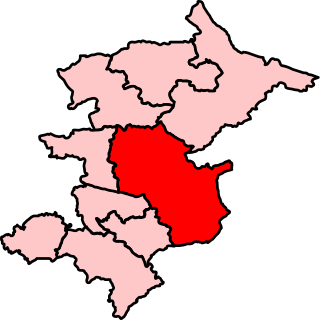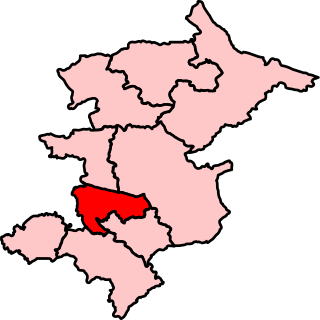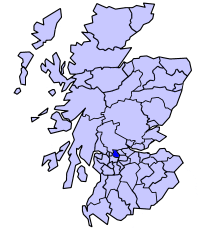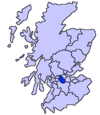
Lanarkshire, also called the County of Lanark, is a historic county, lieutenancy area and registration county in the Central Lowlands of Scotland. The county is no longer used for local government purposes, but gives its name to the two modern council areas of North Lanarkshire and South Lanarkshire.

Stirlingshire or the County of Stirling is a historic county and registration county of Scotland. Its county town is Stirling.

East Dunbartonshire is a county constituency of the House of Commons of the Parliament of the United Kingdom (Westminster). It elects one Member of Parliament (MP) by the first past the post system of election. The seat is possibly best known for formerly being the constituency of Jo Swinson, the former Leader of the Liberal Democrats who was defeated at the 2019 general election. The current MP for the constituency is Amy Callaghan of the Scottish National Party (SNP).

Airdrie and Shotts is a constituency of the Scottish Parliament covering part of the council area of North Lanarkshire. It elects one Member of the Scottish Parliament (MSP) by the plurality method of election. It is also one of nine constituencies in the Central Scotland electoral region, which elects seven additional members, in addition to the nine constituency MSPs, to produce a form of proportional representation for the region as a whole.

Coatbridge and Chryston is a constituency of the Scottish Parliament covering part of the council area of North Lanarkshire. It elects one Member of the Scottish Parliament (MSP) by the plurality method of election. It is also one of nine constituencies in the Central Scotland electoral region, which elects seven additional members, in addition to nine constituency MSPs, to produce a form of proportional representation for the region as a whole.

Central Scotland is one of the eight electoral regions of the Scottish Parliament which were created in 1999. Nine of the parliament's 73 first past the post constituencies are sub-divisions of the region and it elects seven of the 56 additional-member Members of the Scottish Parliament (MSPs). Thus it elects a total of 16 MSPs.

Cumbernauld and Kilsyth is a constituency of the Scottish Parliament (Holyrood) covering part of the council area of North Lanarkshire. It elects one Member of the Scottish Parliament (MSP) by the plurality method of election. It is also one of nine constituencies in the Central Scotland electoral region, which elects seven additional members, in addition to nine constituency MSPs, to produce a form of proportional representation for the region as a whole.

East Kilbride is a constituency of the Scottish Parliament (Holyrood) covering part of the council area of South Lanarkshire. It elects one Member of the Scottish Parliament (MSP) by the plurality method of election. Also, however, it is one of nine constituencies in the Central Scotland electoral region, which elects seven additional members, in addition to nine constituency MSPs, to produce a form of proportional representation for the region as a whole.

Hamilton North and Bellshill was a constituency of the Scottish Parliament (Holyrood). It elected one Member of the Scottish Parliament (MSP) by the plurality method of election. It was also one of ten constituencies in the Central Scotland electoral region, which elected seven additional members, in addition to ten constituency MSPs, to produce a form of proportional representation for the region as a whole.

Hamilton South was a constituency of the Scottish Parliament (Holyrood). It elected one Member of the Scottish Parliament (MSP) by the plurality method of election. It was also one of ten constituencies in the Central Scotland electoral region, which elected seven additional members, in addition to ten constituency MSPs, to produce a form of proportional representation for the region as a whole.

Motherwell and Wishaw is a constituency of the Scottish Parliament (Holyrood) covering part of the council area of North Lanarkshire. It elects one Member of the Scottish Parliament (MSP) by the plurality method of election. It is also one of nine constituencies in the Central Scotland electoral region, which elects seven additional members, in addition to nine constituency MSPs, to produce a form of proportional representation for the region as a whole.

Prior to its uniform adoption of proportional representation in 1999, the United Kingdom used first-past-the-post for the European elections in England, Scotland and Wales. The European Parliament constituencies used under that system were smaller than the later regional constituencies and only had one Member of the European Parliament each.

Hamilton, Larkhall and Stonehouse is a constituency of the Scottish Parliament (Holyrood) covering part of the council area of South Lanarkshire. It elects one Member of the Scottish Parliament (MSP) by the plurality method of election. Also, however, it is one of nine constituencies in the Central Scotland electoral region, which elects seven additional members, in addition to nine constituency MSPs, to produce a form of proportional representation for the region as a whole.

Uddingston and Bellshill is a constituency of the Scottish Parliament (Holyrood) covering part of the council areas of North Lanarkshire and South Lanarkshire. It elects one Member of the Scottish Parliament (MSP) by the plurality method of election. It is also one of nine constituencies in the Central Scotland electoral region, which elects seven additional members, in addition to nine constituency MSPs, to produce a form of proportional representation for the region as a whole.



























